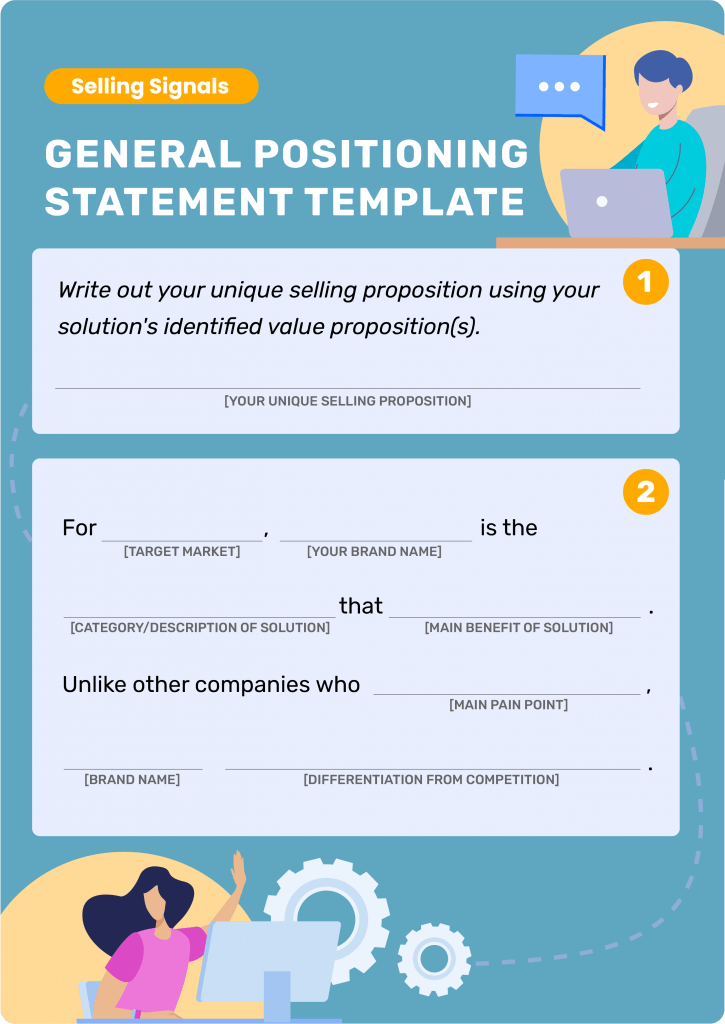-
News & Trends -
Sales -
Marketing Related Topics -
B2B Software Guides Related Topics -
Free Tools & Resources -
- About Us About Us


A positioning statement is a brief description of who your target market is and how your product or service can fill their need. This statement is used in internal company communication for sales and marketing teams to define the value of their solution and how it stands apart from its competitors. The most successful positioning statements include a clear address of the target market, the problem your solution can solve, and the reason your solution is the best option.
A positioning statement acts as a beacon for how you want your product or service, and brand as a whole, to be marketed and perceived by the target audience. The statement itself can vary in length, ranging from a couple sentences to a short paragraph. As long as you convey the proper information through clear and concise messaging, the syntax and style of language in the positioning statement can be flexible.
A successful positioning statement should answer the following questions:
Positioning statements are typically used as internal tools throughout marketing and lead nurturing strategies to ensure consistency in how your brand is perceived. You’ll use this positioning statement throughout your product positioning process and as you develop your brand. While it’s your opportunity to showcase how you deliver solutions and why your solution is superior, the solution itself should be able to back any claims made in your positioning statement.
From researching your target market to implementing your statement into your positioning campaigns, taking the time to craft your positioning statement will help build your brand’s foundation. This will influence how your marketing team will target leads, and how your sales team will nurture them. As you begin writing your own positioning statement, it’s helpful to follow a defined process and use a ready-made template.
Here’s a downloadable positioning statement template that you can edit to fit your needs. We’ve incorporated all the major components of an effective positioning statement into this customizable template that you can use as you follow the steps to writing your own. Click the template below to make your own copy and replace the bolded information with your company's.

Though positioning statements are brief, they require research on the front end before you even get to drafting. To write an effective positioning statement, first you need to define your target audience and your own unique selling proposition, then use that information to draft the statement itself. Finally, before implementation, review the statement and finalize its tone and style.
Your target market is the audience you’re intending to serve — they’re consumers of your solution or solutions like it. You find your target market by first building a customer profile, which consists of demographic, technographic, and general behavioral characteristic data of your average consumer. Condense the lengthy report that is your customer profile into a short summary that captures the essence of your average customer, and that is your target market.
Examples of target markets for specific industries include:
Once you identify a target market, you can start researching their buyer experience with a product or service like yours. The best way to understand your target market is to gather research material like case studies and customer reviews. Analyze your customer data, conduct behavioral studies, or host focus groups to visualize how and why your target market makes purchases like your solution.
A unique selling proposition (USP) is a short value statement that explains how your product or service is different from — and better than — your competition. To discover what your product’s key differentiator is, you’ll research your competition and their solutions to find what value proposition your product or service has that stands out in the market.
Seven of the most common value propositions include:
Use any one or more of these value propositions as inspiration when establishing your USP. Consider how any of them can position your product or service as the better solution compared to competitors in your industry. Then use that key insight into drafting the positioning statement itself.
For the full steps to create your USP, check out our complete guide on unique selling propositions. There, you'll also learn about the common value propositions the best USPs communicate and see examples from real companies.
With your target audience and USP ready to go, you’ll start writing the positioning statement that brings all this information together. Begin by writing out each component individually before trying to craft a complete statement in one go. This way, you’ll ensure you’re addressing each element of the positioning statement fairly.
The main components of a successful positioning statement are:
Once you’ve written out each component above, start drafting a complete positioning statement that flows naturally. Since this statement will help you build out your brand identity, include language and syntax that’s cohesive with the overall impression you wish your brand to leave. Here's the first draft of a sample positioning statement:
First Draft: Sailor Fan Co. is an industrial ventilation distributor that builds, installs, and maintains property ventilation systems for commercial properties. Unlike our top competitors who require frequent and time-consuming maintenance, Sailor Fan Co. offers a lifetime warranty.
Before you commit to the first or second draft of your positioning statement, take the time to revise the statement for errors. This statement will influence the marketing decisions of your solution. So, consider asking trusted peers to review it or comparing it to the positioning statements of other successful companies in your industry.
After workshopping the sample positioning statement above, it's clear that the first draft has a product description, audience need, and USP but lacks a strong address of the target market. This second version solves that by starting with an address of the target market.
Second Draft: For owners of commercial properties, Sailor Fan Co. is the leading industrial ventilation distributor that builds, installs, and remotely maintains property ventilation systems. Unlike other companies who require frequent and time-consuming maintenance, Sailor Fan Co. offers a lifetime warranty for domestic customers.
This final draft has all five components of a successful positioning statement, uses cleaner language, and has a better overall flow.
Final Draft: For commercial property owners, Sailor Fan Co. is the leading industrial ventilation distributor that builds, installs, and remotely maintains property ventilation systems. Unlike other companies who require frequent and time-consuming maintenance, Sailor Fan Co. offers a lifetime warranty for domestic customers.
Experiment with the order in which you include each component and the language you use. Starting with your key differentiator could act as an attention grabber for the reader and set a powerful tone for your solution. With the help of feedback and suggested edits, the goal is to effectively position your solution to help marketers and sales teams develop your customer experience.
Always mention your target audience early in the positioning statement, if not right at the beginning. This way, those who read it will instantly understand that your target market is the focus of your entire product positioning.
Once you have a completed and approved positioning statement, it’s time to deploy it to all company employees. The positioning statement shouldn’t be known by just the marketing and sales teams. It’s important for the revenue, content, IT, and all other departments to be familiar with your brand’s positioning statement as well. This is because the positioning statement helps keep the values and priorities of the brand front and center.
A positioning statement can be implemented primarily in the development of marketing and ad campaigns as well as lead nurturing strategies.
A positioning statement can be used as a tool to ensure all marketing efforts are appropriately aligned with the brand identity you’ve created. Marketers who know who their target market is can cater all marketing toward them and their needs. Positioning statements also clearly state an effective USP, which can be used in creative ad campaigns. The language and tone of your statement also can influence marketing content for a consistent voice across company media.
With a positioning statement, sales teams have a clearly defined target market, that market’s pain points, and USP. All of this information is valuable when it comes to mapping out a lead nurturing strategy. With a strong positioning statement, you know exactly what factors your lead prioritizes when purchasing a solution to their problem. Whether it's cost, solution reliability, or convenience, sales teams can match nurturing methods appropriately to get the lead closer to making a purchase.
After sending out your positioning statement to the company and implementing it in marketing and selling strategies, the brand identity will be consistent across all fronts. All decisions moving forward will be guided by your product positioning to ensure cohesive values, language, and lead interaction.
Following these five steps will ensure you’ve gathered all the insight and research needed to write a compelling and effective positioning statement. It’s beneficial when creating your own statement to read examples of companies in similar industries as your own.
Below we’ve written 10 positioning statement examples for different industries and mock companies. We’ve also included some insight as to why they work so well. Read through our examples for some inspiration when making your own.
What It Is: For drivers of long distances or who carry valuable cargo, Apollo is an automotive manufacturer that builds dependable and eco-friendly vehicles. When facing long journeys for whatever your reason, Apollo is an affordable manufacturer that puts comfort and safety first with innovative technology to help you safely get coast to coast.
Why It Works: In this example, the target market is immediately identified as drivers of long distances or who carry valuable cargo. It then goes on to follow our template above, listing out all five components including a need, benefit, and a catchy USP.
What It Is: For adolescent users interested in expressing themselves through short form videos, Boss is a social media platform that encourages self expression in a safe and monitored environment. Boss offers a unique parental advisory service so parents feel at ease while young users learn to express themselves in this digital age.
Why It Works: This example positioning statement also uses our template structure above. Along with all the necessary information, the USP in this statement uses brand-friendly language that can be used in future campaigns like “feel at ease” and “encourage self expression.”
What It Is: For customers looking for healthy and quick alternatives to fast food, Jeepers is a top chain restaurant that offers farm fresh food through drive-thrus. While our competitors also offer quick and friendly service, Jeepers prioritizes food quality and uses local farmers and distributors.
Why It Works: This positioning statement example presents its USP by directly addressing its competitive advantage. Jeepers is saying it does all the things its competitors do, like offering quick and friendly service, plus some — like the use of local farmers and food distributors.
What It Is: For athletes or anyone who exercises regularly, Wax is an inclusive athletic clothing brand that offers high quality and gender neutral sports apparel and accessories. Wax prioritizes inclusive branding and uses innovative and award winning fabrics and materials.
Why It Works: Wax clearly defines the target audience as being “athletes or anyone who exercises regularly” and how they solve that audience's need with high quality and gender neutral apparel. This positioning statement has a USP that mentions its corporate responsibility through “inclusive branding.”
What It Is: For users looking to connect with friends and family across the world, Hay is a messaging platform that allows international calls and messages. Instead of paying per minute for international calls, Hay allows unlimited 5G video and texting for an affordable flat yearly fee.
Why It Works: This positioning statement openly states the biggest pain its users face, which is pricey pay-per-minute calls, and how their solution addresses that head on with its USP being a refreshing affordable flat fee charged yearly.
What It Is: For patients looking for minor accessible health care, SentHealth is an online health care provider that hosts virtual consultations with board-certified doctors. Instead of wasting time driving to appointments and then to pharmacies, SentHealth can connect you to providers and ship out most prescriptions right to your doorstep.
Why It Works: This example demonstrates how to use language to create a brand identity by using casual phrases like “wasting time” instead of more formal alternatives when describing a major pain point of their target audience. It’s also mindful of saying “most prescriptions” so the statement doesn't overpromise.
What It Is: For those looking for a home theater experience, Boothe is a top subscription based video streaming service that has over 40,000 movies and shows to choose from. When facing such a large vault of content, Boothe uses unique AI software to filter movies and shows to match your specific mood.
Why It Works: A common pain point for streaming service users can be the fact that there are sometimes too many options. Boothe, in this positioning statement, takes the need for more intuitive streaming by using AI technology to create a unique solution for its users.
What It Is: For individuals wanting affordable and child-safe devices like phones and tablets, Pear is a leading technology manufacturer that makes such portable devices. To ensure child safety, Pear uses innovative technology to create time and user parameters so certain sites, apps, and functions can be accessed or restricted.
Why It Works: In this example, Pear lists itself as a leading provider in its category and industry. They back this claim by explaining how they use innovative technology to solve the immediate needs of the target market.
What It Is: For buyers wanting authentic vintage clothing and accessories, Koi Reselling is an online reselling platform that securely connects buyers and sellers. Instead of sending money through unreliable third-party platforms, Koi Reselling can send and track secure payments, as well as verify receipts.
Why It Works: This positioning statement is a great example of using the main issue the target audience faces — in this case, security — to help frame the USP, which is they offer secure payment processing.
What It Is: For those wanting a unique and inclusive tropical vacation experience, Cloud Resorts are international tourist destinations that cater to guests with disabilities. Instead of having to request special accommodations that may not even be available, all Cloud Resorts are wheelchair accessible with sensory sensitivity.
Why It Works: Like the examples above, this positioning statement starts by defining the target market right away. There is common language like “inclusive,” “accessible,” and “sensitive” throughout that helps maintain an appropriate tone while building the case for the USP.
These positioning statements are great examples of identifying your target market and declaring how your product or service proves itself as a solution for that market. Reference these examples and our expert tips below when writing your positioning statement.
When drafting your positioning statement, there are tips and tricks to keep in mind while crafting a strong and effective statement. This includes keeping the positioning statement itself short in length by using clear language, only guaranteeing outcomes you can control, and researching other statements for ideas.


Founder & CEO
“Conducting research on your competitors and their positioning statements is essential when writing your own. This will help you identify any gaps in the market that could be filled by your own offering.”
— Nick Stekovic, Project Management Revolution


CEO & Owner
“A valuable positioning statement should be authentic and credible. Avoid making exaggerated claims or promises that cannot be substantiated. Instead, focus on highlighting your genuine strengths and capabilities. This builds trust and confidence among your audience, reinforcing your position as a reliable and trustworthy option.”
— Adam Garcia, The Stock Dork


CEO & Co-founder
“To make it effective, it needs to clearly communicate how your product or service solves a specific problem and why it's better than the competition. Use strong, action-oriented language and ensure that it's easily understood by anyone who reads it. Avoid using buzzwords and industry jargon that may be confusing.”
— Simon Bacher, LingApp


Chief of Marketing
“Your positioning statement should be reviewed regularly to ensure it is still relevant to your target audience and your product or service. Your statement can adapt just as often as your company or market does.”
— Jaden Oh, TRAFFV
Implementing these tips will help your positioning statement come across as clear and effective while also keeping your brand's identity front and center.
While both a positioning and mission statement help represent a brand, their overall objectives differ. A mission statement presents the core values of a company or organization and is printed in ad campaigns or corporate content, or can be located on the company’s website. A positioning statement focuses on the benefits a solution provides compared to its competitors, and is used as more of an internal tool to inspire and shape future branded campaigns.
A unique selling proposition (USP) is a declaration of how your solution is outright better than the competition and can be found directly in ads, on websites, or any branded messaging for your product. Positioning statements include a short description of your solution, your target market, and lastly, a USP.
While positioning statements usually contain USPs or a combination of value propositions, they’re mainly used as an in-house tool for marketing and strategizing.
Positioning statements act as an opportunity to acknowledge your target market and introduce your solution as it stands apart from your competitors. The information conveyed in your statement will frame your company’s entire identity regarding the solution you offer to customers. Positioning statements and product positioning as a whole will help sales teams determine the most effective lead nurturing stages that align with the established brand.


Allyssa is a sales writer with a background in B2B sales and account management. After earning her degree in English and communications, she spent her selling career supporting Fortune 1000 IT and finance companies including Bank of America, Wells Fargo, and Credit Karma. As a staff writer for Selling Signals, her specialties include lead nurturing, lead generation, and sales software topics. When she's not writing or updating articles, you can find Allyssa writing poetry, traveling, or picking up any new creative hobby.

Selling Signals delivers actionable advice for sales and marketing professionals. Learn strategies that help you hit targets, strengthen customer relationships, and win more business. Get expert advice on lead generation, sales processes, CRM software, sales management, and account management directly to your inbox.
Property of TechnologyAdvice. © 2025 TechnologyAdvice. All Rights Reserved
Advertiser Disclosure: Some of the products that appear on this site are from companies from which TechnologyAdvice receives compensation. This compensation may impact how and where products appear on this site including, for example, the order in which they appear. TechnologyAdvice does not include all companies or all types of products available in the marketplace.